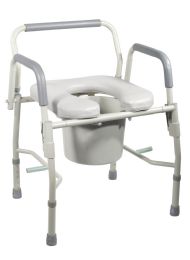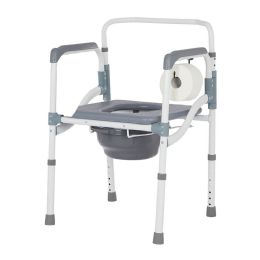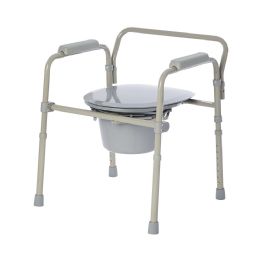




















What is a Commode?
While the word actually refers to specific types of furniture, the commode has become synonymous with chairs that enclose a chamber pot. In some parts of the world, the commode is also used interchangeably with the toilet. Portable commodes are formulated to look like a toilet, but will not have any attached plumbing or running water. They are usually placed next to the bedside for the convenience of users who are unable to ambulate to the bathroom, or may be moved to different rooms throughout the day, dependent upon where the user will be.
There are many variations in styles of commodes, but the basic construction looks like a chair with four legs that has an open seat, a bucket or container to catch waste, and a lift up cover, just like a regular toilet seat features. The container can be removed to empty the waste into a regular, flushable toilet. Other style variations include the capability to use the portable commode over a regular toilet, making it more stable and height-adjustable for users still able to use the bathroom. Also referred to as bedside commodes, commode chairs, shower commodes or toilet chairs, portable commodes are often utilized in hospitals, long-term care facilities, rehabilitation centers and for in-home usage.
What are the Advantages of Portable Commodes?
The biggest advantage in utilizing a portable commode is that the commode can be transported to the user, instead of the user trying to get to the bathroom. When an individual has mobility challenges, such as post-surgery, during rehabilitation or after an accident or injury, it is not always feasible for them to use the usual bathroom facilities. People with worsening disabilities or seniors who are getting weaker and more prone to falls often use portable commodes, as well.
Aside from the close proximity benefit, there are also many other helpful highlights with using a commode chair. Their height adjustability makes them easier for most individuals to use, reducing discomfort that often occurs in the user’s back or legs when using a regular toilet. Some commode frame configurations can be placed over a regular toilet to provide a more accessible and height-appropriate seat for the user.
Several commode chairs come with lockable wheels for easier portability, while others can simply be folded down or quickly disassembled to set up in another room, or to be transported in a vehicle. Most commode chairs are very lightweight and can also be moved easily by a caregiver or family member. Design styles generally include arm rests for comfort and stability in getting up and down from the chair, while some styles also include removable back rests. The arm rests may have the capability to be removed for improved accessibility for patient transfers to and from a bed or wheelchair, while the back rest can be removed to use the commode over an existing toilet.
Versatile and accessible, portable commodes are available in a range of sizes to more perfectly suit every user, from pediatric to bariatric. Often performing double-duty as shower chairs, portable commodes are constructed with highly durable materials that are usually rust-resistant, mildew-resistant and easy to keep clean and maintain.
Rehabmart is pleased to offer a wide selection of superior quality commodes from an impressive array of innovative medical vendors that include Independence Medical, Invacare, Medline, Drive Medical, TFI Healthcare, Sammons Preston, Roscoe Medical and many more.
Hulet Smith, OT
Rehabmart Co-Founder & CEO
ck